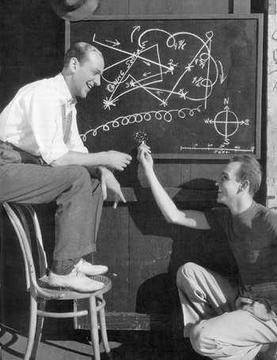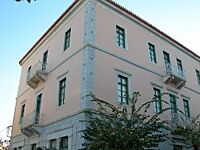Hermes Pan facts for kids
Quick facts for kids
Hermes Pan
|
|
|---|---|
 |
|
| Born |
Hermes Joseph Panagiotopoulos
December 10, 1909 Memphis, Tennessee, U.S.
|
| Died | September 19, 1990 (aged 80) |
| Occupation | Dancer, choreographer |
| Years active | 1928–1968 |
Hermes Pan (born Hermes Joseph Panagiotopoulos, December 10, 1909 – September 19, 1990) was an American dancer and choreographer. He is best known for working with Fred Astaire on many famous movie musicals in the 1930s. These movies often starred Astaire and Ginger Rogers.
Hermes Pan worked on almost two dozen films and TV shows with Fred Astaire. He won an Oscar and an Emmy for his amazing dance direction.
Born in Memphis, Tennessee, Hermes was the son of a Greek immigrant father and an American mother. When he was 14, his family moved to New York City. He started dancing in amateur shows and clubs. He earned his first money from dancing at age 19. He then worked in several Broadway shows. In 1930, he moved to California. There, he met Fred Astaire in 1933 and began their long partnership. He choreographed 89 films in total.
Contents
Early Life and Family
Hermes Joseph Panagiotopoulos was born in 1909 in Memphis, Tennessee. His father, Pantelis Panagiotopoulos, was a Greek immigrant. His mother, Mary Aljeanne Huston, was from the Southern United States. Her family had lived there since colonial times. Hermes's father was a candy maker. His family in Aigio, Greece, was well-known and had even opened the first theater in their city.
In 1895, Pantelis Panagiotopoulos represented Aigio at an event in Nashville, Tennessee. He was called a "Greek Consul to the South." He planned to return to Greece. However, he met Mary Huston in Nashville in 1900 and decided to stay. They married in 1901.
In 1903, Pantelis became a U.S. citizen. He and Mary moved to Memphis, where their first son, Panos, was born. Their daughter, Vasso Maria, was born in 1906. Both children were named after Pantelis's parents. The family was doing well. Pantelis was president of a company that owned a hotel and cafe. Hermes, their second son and last child, was born in Memphis in 1909.
In 1911, the family moved back to Nashville. Pantelis opened his own restaurant. Hermes loved music and dance from a young age. In 1915, "Aunt Betty" Clark, the children's nanny, took Hermes to her neighborhood. There, he learned about jazz music and tap dance. This experience greatly influenced him.
Hermes became friends with Aunt Betty's son, Sam Clark, who also worked for his family. Sam was a talented dancer. He taught Hermes many popular dances of the time. Hermes practiced these dances on his own.
Moving to New York City
In 1923, Hermes's mother, Mary, shortened the family name to Pan. She moved her family to New York City, along with Sam Clark. At first, they had enough money to live comfortably. But soon, their money ran out. One day, they had only potatoes and coffee to eat. They decided to remember this day, June 13, every year as a family celebration. Sadly, Hermes's older brother, Panos, who had helped support the family, died in 1927.
Hermes Pan's dance career began when he was 19. He appeared as a chorus boy in the 1928 Broadway show Animal Crackers, starring the Marx Brothers. In 1930, he met Ginger Rogers while working as a chorus singer in the Broadway musical Top Speed. He also danced with his sister Vasso. Both Hermes and Vasso moved to Los Angeles by 1930.
Hermes, Vasso, their mother Mary, and their brother's widow Dorothy and daughter Aljeanne shared a house. Later, Hermes bought a house in Beverly Hills. Vasso Pan also danced in the chorus of many of the Astaire-Rogers movies.
Hermes Pan stayed in touch with his father's family in Greece. In the 1920s, he visited Aigio to meet them.
Working with Fred Astaire

Hermes Pan met Fred Astaire on the set of the movie Flying Down to Rio (1933). Pan was helping the dance director. Astaire was trying to figure out steps for a dance called "The Carioca." Someone told Astaire that Pan had some ideas. Pan showed him a dance move he had learned from his street dancing days in New York.
From that moment, they started a long-lasting professional partnership and friendship. Pan worked on all the RKO movies with Astaire. He was nominated for Academy Awards for the "Top Hat" and "The Piccolino" dances from Top Hat (1935). He was also nominated for the "Bojangles of Harlem" dance from Swing Time (1936). In 1937, he won an Academy Award for Best Dance Direction for A Damsel in Distress.
The partnership between Astaire and Pan was very important in 20th-century film and TV musicals. Pan worked on 17 of Astaire's 31 musical films and three of his four TV specials. Astaire called Pan his "idea man." Astaire usually choreographed his own dances. However, he greatly valued Pan's help as a critic and a rehearsal partner.
Astaire practiced his routines a lot, so Pan's help was very important. Pan also taught and rehearsed with Ginger Rogers. Rogers often had other commitments during filming, which made it hard to match Astaire's rehearsal schedule. Also, Pan recorded Ginger's tap sounds after filming for all their movies made after Roberta (1935).
Pan continued to work with Astaire until Astaire's last musical movie, Finian's Rainbow (1968). The young director, Francis Ford Coppola, had no experience with musicals. He did not follow Astaire's and Pan's plans for the dances. Coppola brought back an old style of filming dances where the camera moved a lot. Astaire had worked hard to stop this style in Hollywood musicals. Coppola eventually fired Pan, who had a small acting part in the film. Coppola later admitted that he was responsible for the movie's artistic problems.
Film Appearances and Other Work
Pan's first on-screen appearance was as a clarinet player in Second Chorus (1940). He was also "The Ghost" in a deleted dance scene with Astaire from the same film.
He danced with Betty Grable in Moon Over Miami (1941) and Coney Island (1943).

His longest filmed dance routine is a complex tap duet with Betty Grable in Footlight Serenade (1942). This dance shows how much his work was like Astaire's and Rogers's. Pan also appeared with Rita Hayworth in My Gal Sal (1942) and with Betty Grable again in Pin Up Girl (1944). In these movies, he mostly danced and choreographed. He did not have speaking roles. In 1950, he danced with Lana Turner in a party scene in A Life of Her Own. These are his only dance performances on film. They allow people to compare Pan's dance style to Astaire's.
When he wasn't working with Astaire, Pan was a very popular choreographer during the golden age of Hollywood musicals. He was known for understanding how the camera saw dance. He helped change how dance was filmed and how Americans watched dance. He helped choreograph the all-black musical Lucky Day (1936–37). He also choreographed Lovely to Look At (1952), Kiss Me Kate (1953), and Pal Joey (1957). In Pal Joey, he made his final on-screen appearance as a choreographer leading chorus girls.
Awards and Recognition
- Nominated for Academy Awards for the "Top Hat" and "The Piccolino" dance numbers from Top Hat (1935).
- Nominated for Academy Award for the "Bojangles of Harlem" dance number from Swing Time (1936).
- Won the Academy Award for Best Dance Direction for A Damsel in Distress (1937).
- Won an Emmy Award for the 1961 TV special, An Evening with Fred Astaire.
- Received a National Film Award in 1980.
- The Joffrey Ballet gave him an award in 1986 for his contributions to American dance.
- Credited as Choreographer for the 1968 Edition of Folies Bergere at The Tropicana Hotel Las Vegas.
Filmography
Choreographer
- Flying Down to Rio (1933) (assistant)
- The Gay Divorcee (1934)
- Roberta (1935)
- Old Man Rhythm (1935)
- Top Hat (1935)
- In Person (1935)
- I Dream Too Much (1935)
- Follow the Fleet (1936)
- Swing Time (1936)
- Shall We Dance? (1937)
- Damsel in Distress (1937)
- Radio City Revels (1938)
- Carefree (1938)
- The Story of Vernon and Irene Castle (1939)
- Second Chorus (1940)
- Sun Valley Serenade (1941)
- That Night in Rio (1941)
- Blood and Sand (1941) (uncredited)
- Moon over Miami (1941) (also dancer)
- My Gal Sal (1942) (also dancer)
- Footlight Serenade (1942) (also dancer)
- Song of the Islands (1942)
- Springtime in the Rockies (1942)
- Hello, Frisco, Hello (1943)
- Coney Island (1943)
- Sweet Rosie O'Grady (1943) (also dancer)
- Pin Up Girl (1944) (also dancer)
- Irish Eyes Are Smiling (1944)
- Billy Rose's Diamond Horseshoe (1945)
- Blue Skies (1946)
- I Wonder Who's Kissing Her Now (1947)
- The Barkleys of Broadway (1949)
- Three Little Words (1950)
- Let's Dance (1950)
- Excuse My Dust (1951)
- Texas Carnival (1951)
- Lovely to Look At (1952)
- Sombrero (1953)
- Kiss Me Kate (1953)
- The Student Prince (1954)
- Jupiter's Darling (1954)
- Hit the Deck (1955)
- Meet Me in Las Vegas (1956)
- Silk Stockings (1957)
- Pal Joey (1957)
- Porgy and Bess (1959)
- The Blue Angel (1959)
- Can-Can (1960)
- Flower Drum Song (1961)
- Cleopatra (1963)
- My Fair Lady (1964)
- Finian's Rainbow (1968) (also actor)
- Darling Lili (1970)
- Lost Horizon (1973)
- Help Me Dream (1981)
Actor
- Second Chorus (1940) – College Clarinetist (uncredited)
- Moon over Miami (1941) – Kay's Dance Partner in Conga Number (uncredited)
- My Gal Sal (1942) – Sally's Dancing Partner
- Footlight Serenade (1942) – Assistant Dance Director (uncredited)
- Coney Island (1943) – Specialty Dancer (uncredited)
- Sweet Rosie O'Grady (1943) – Madge's Dancing Partner (uncredited)
- Pin Up Girl (1944) – Apache Dancer (uncredited)
- A Life of Her Own (1950) – Specialty Dancer
- Kiss Me Kate (1953) – Sailor (uncredited)
- Pal Joey (1957) – Choreographer at Dress Rehearsal (uncredited) (final film role)
Later Life and Legacy
Hermes Pan never married. He had a niece named Michelene Laski.
Pan had many friends both inside and outside of Hollywood. He became friends with the Shah of Iran, Mohammad Reza Pahlavi. He was also close friends with the painter Diego Rivera, who painted his portrait. He was very close to Rita Hayworth and was a pallbearer at her funeral.
Toward the end of his life, Pan visited Greece. He spent time in his father's hometown of Aigio. There, he visited his family's mansion and met many relatives.
Hermes Pan passed away in Beverly Hills, California, on September 19, 1990, at the age of 80. He was survived by his sister Vasso Pan, his niece Michelene Laski, and other nieces and nephews.



